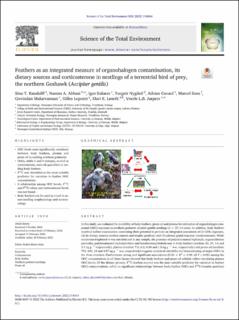| dc.contributor.author | Randulff, Sina Thu | |
| dc.contributor.author | Abbasi, Naeem A. | |
| dc.contributor.author | Eulaers, Igor | |
| dc.contributor.author | Nygård, Torgeir | |
| dc.contributor.author | Covaci, Adrian | |
| dc.contributor.author | Eens, Marcel | |
| dc.contributor.author | Malarvannan, Govindan | |
| dc.contributor.author | Lepoint, Gilles | |
| dc.contributor.author | Løseth, Mari Engvig | |
| dc.contributor.author | Jaspers, Veerle | |
| dc.date.accessioned | 2023-01-19T12:49:10Z | |
| dc.date.available | 2023-01-19T12:49:10Z | |
| dc.date.created | 2022-04-13T14:38:02Z | |
| dc.date.issued | 2022 | |
| dc.identifier.citation | Science of the Total Environment. 2022, 828 . | en_US |
| dc.identifier.issn | 0048-9697 | |
| dc.identifier.uri | https://hdl.handle.net/11250/3044623 | |
| dc.description.abstract | In this study, we evaluated the suitability of body feathers, preen oil and plasma for estimation of organohalogen compound (OHC) exposure in northern goshawk Accipiter gentilis nestlings (n = 37; 14 nests). In addition, body feathers received further examination concerning their potential to provide an integrated assessment of (1) OHC exposure, (2) its dietary sources (carbon sources and trophic position) and (3) adrenal gland response (corticosterone). While tetrabromobisphenol A was not detected in any sample, the presence of polychlorinated biphenyls, organochlorine pesticides, polybrominated diphenyl ethers and hexabromocyclododecane in body feathers (median: 23, 19, 1.6 and 3.5 ng g−1 respectively), plasma (median: 7.5, 6.2, 0.50 and 1.0 ng g−1 ww, respectively) and preen oil (median: 750, 600, 18 and 9.57 ng g−1 ww, respectively) suggests analytical suitability for biomonitoring of major OHCs in the three matrices. Furthermore, strong and significant associations (0.20 ≤ R2 ≤ 0.98; all P < 0.05) among the OHC concentrations in all three tissues showed that body feathers and preen oil reliably reflect circulating plasma OHC levels. Of the dietary proxies, δ13C (carbon source) was the most suitable predictor for variation in feather OHCs concentrations, while no significant relationships between body feather OHCs and δ15N (trophic position) were found. Finally, body feather corticosterone concentrations were not related to variation in OHC concentrations. This is the first study to evaluate feathers of a terrestrial bird of prey as an integrated non-destructive tool to jointly assess nestling ecophysiology and ecotoxicology. | en_US |
| dc.language.iso | eng | en_US |
| dc.publisher | Elsevier | en_US |
| dc.rights | Attribution-NonCommercial-NoDerivatives 4.0 Internasjonal | * |
| dc.rights.uri | http://creativecommons.org/licenses/by-nc-nd/4.0/deed.no | * |
| dc.title | Feathers as an integrated measure of organohalogen contamination, its dietary sources and corticosterone in nestlings of a terrestrial bird of prey, the northern Goshawk (Accipiter gentilis) | en_US |
| dc.title.alternative | Feathers as an integrated measure of organohalogen contamination, its dietary sources and corticosterone in nestlings of a terrestrial bird of prey, the northern Goshawk (Accipiter gentilis) | en_US |
| dc.type | Peer reviewed | en_US |
| dc.type | Journal article | en_US |
| dc.description.version | publishedVersion | en_US |
| dc.source.pagenumber | 8 | en_US |
| dc.source.volume | 828 | en_US |
| dc.source.journal | Science of the Total Environment | en_US |
| dc.identifier.doi | 10.1016/j.scitotenv.2022.154064 | |
| dc.identifier.cristin | 2017217 | |
| cristin.ispublished | true | |
| cristin.fulltext | original | |
| cristin.qualitycode | 2 | |

